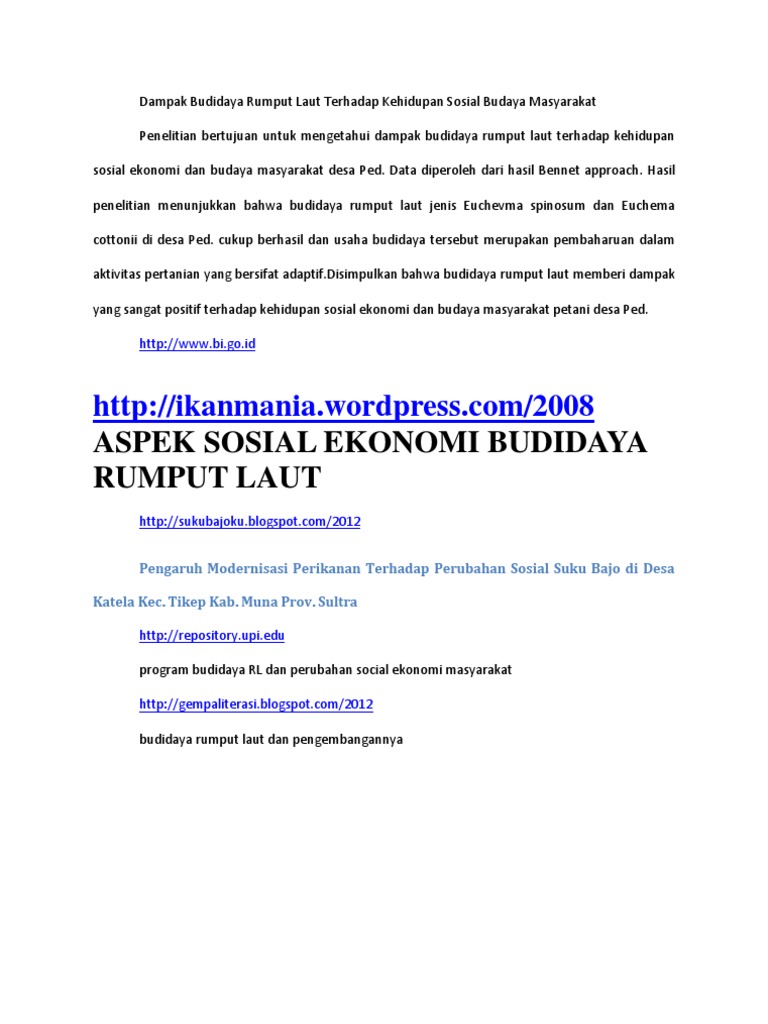Budidaya Rumput Laut Pdf Download
AbstractThis research was canied out to support the strategic plan of the Ministry of Marine Affairs and Fisheries of Repuhlic of lndonesia that seeks to increase fisheries production through the aquaculture. Objective of this study is providing information of potential area for seaweed cultivation around Kaliuda village water territory, East Sumba, Nusa Tenggara Timur. Remote sensing data (terra or aqua MODIS satellite image), field survey data and secondary data were used for this study. Remote sensing data were used to produce Total Suspended Matter and Chlorophyll-a information, field survey data pmvided nitrate, phosphate, salinity, bottom substrate and water transparency while secondary data was used to provide bathymetry information.
Budidaya rumput laut di tambak merupakan upaya untuk memanfaatkan tambak-tambak yang tidak produktif dan juga mampu memberi sumbangan terhadap tingkat kesuburan perairan tambak (S etianingsih, 2011). Sedangkan untuk rumput laut yang. Banyak dibudidayakan dilaut adalah dari jenis Kappaphycus dan Euchema. BUDIDAYA RUMPUT LAUT, Kappaphycus alvarezii SECARA TERINTEGRASI DENGAN IKAN KERAPU DI TELUK GERUPUK KABUPATEN LOMBOK TENGAH. Rumput laut adalah nama umum untuk menyebut pelbagai jenis organisme. TEKNIK BUDIDAYA RUMPUT LAUT DENGAN METODE TALI PANJANGOleh. Wisnu Sujatmiko dan Wisman Indra Angkasa.
Manfaat Rumput Laut
Geographical Information System software was used to analyze this study by using overlay technique for all parameter, which had previously been weighted and scored based on the criteria of aquatic habitat suitability. Higher score indicates that the area more suitable for marine aquaculture activities. The results showed that the potential area suitable for seaweed cultivation activities around Kaliuda village water territory, east Sumba, Nusa Tenggara Timur is about 4,79 km2 or only 24,69% from total 19,41 km. study area.
The purpose of this research was to provide data on waters physical and chemical parameters, proper areal map, carrying capacity, and potential production of seaweed. Research method used was spacial approach through direct measurement in the field and through laboratory analysis. Ten observation stations were established purposively at Desa Arakan waters. Samples were collected four times at two weeks interval. It was found that water temperature was 31–31,25 ºC, flow rate 5,97–11,09 cm/det., dissolved oxygen 5,34–6,45 mg/l, pH 7,7–8,1, salinity 32,5-33 ppt, nitrate 5,02–5,25 mg/l, phosphate 0,01–0,14 mg/l, water depth 1,3–16,5 m, velocity 1,3–4,5 m, tide 0–283 cm with Mean Sea Level 75,6 cm. Bottom substrate consisted of coral sand and muddy sand. Proper culture area based on SIG analysis was 134.64 ha in which very proper areal was 68.40 ha, proper 66.23%.

Gambar Rumput Laut

Rumput Laut Adalah
While proper areal was 66.23 ha. Based on carrying capacity analysis, proper sustainable site was 126.57 ha. This area could support 1.054 long line measuring 20x60 cm each. Seaweed potential was 3363,7 ton per ha or 4.4 ton/ha/year or 4.4 ton/ha/planting season.Keywords: marine seaweed, water quality, SIG, sea water, SIG, carrying capacity, production.